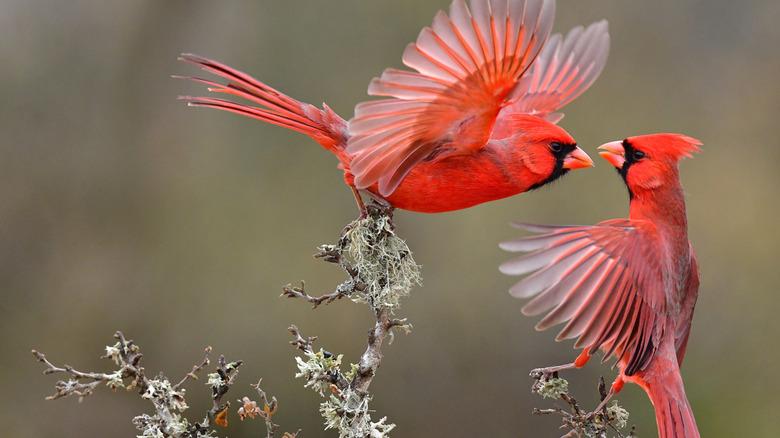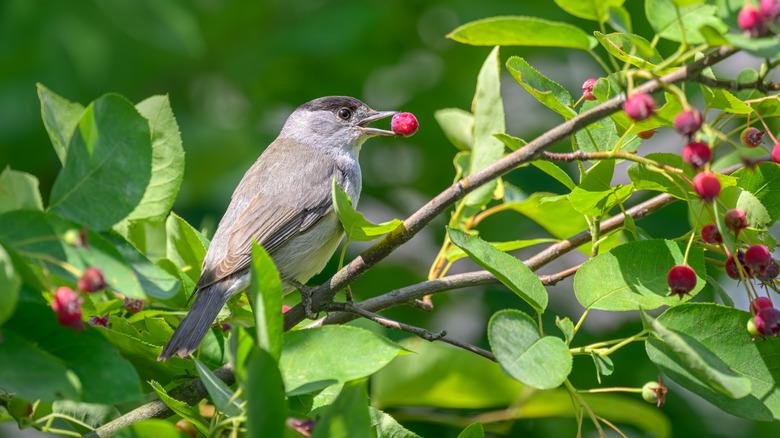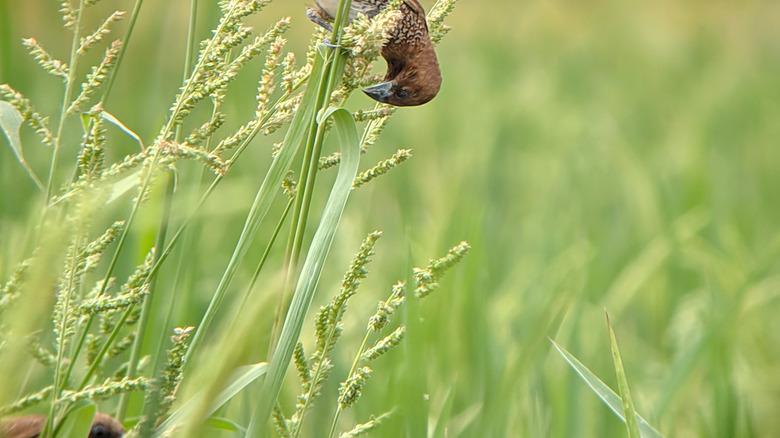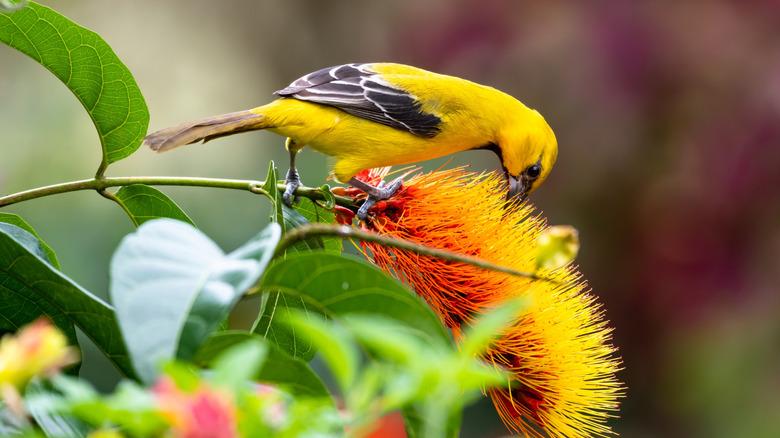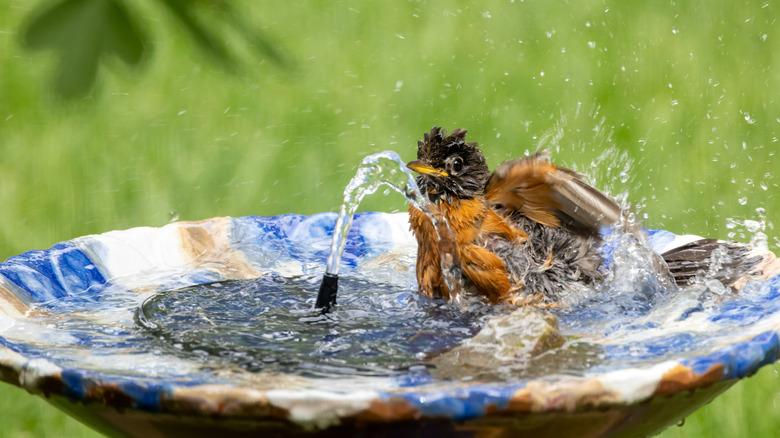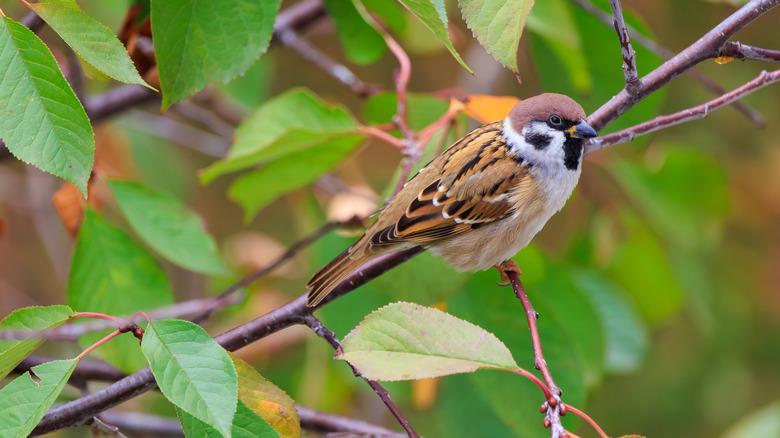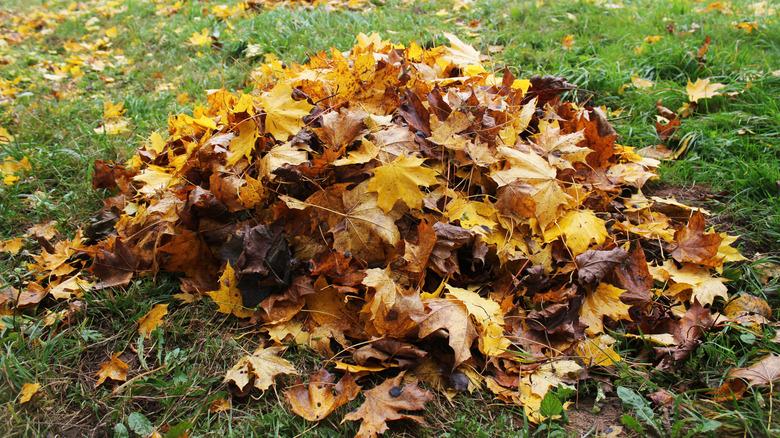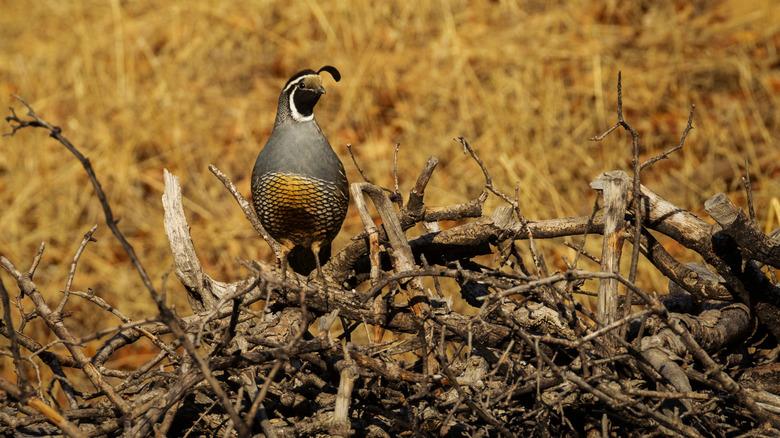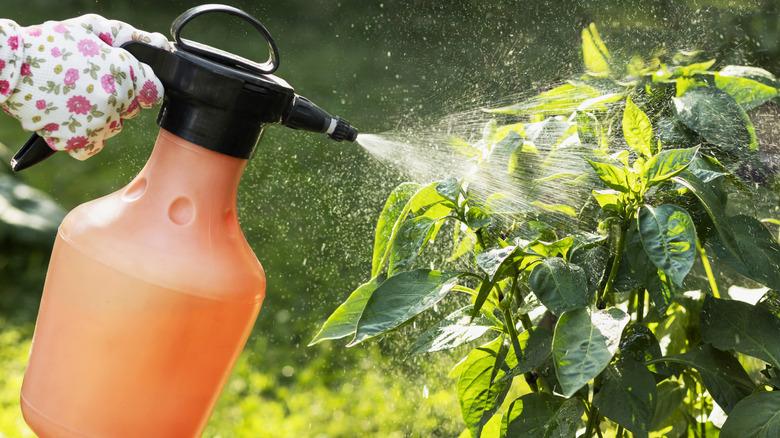11 Foolproof Ways To Attract Birds To Your Yard And Garden Without Buying A Feeder
It's common for bird lovers to install feeders to attract their favorite species, but they can sometimes cause more harm than good. While both feeding stations and plants will have birds flocking to your yard, feeders concentrate food in one small area, forcing birds to gather closely, increasing the risk of spreading disease. Seeds and leftover hulls can decompose or grow mold quickly, which can make birds sick, and other avian diseases can spread rapidly at contaminated feeders. Although regularly cleaning the feeders helps reduce the risk, not everyone has time for the upkeep required. Seed feeders need to be disassembled and thoroughly cleaned at least twice a month, while hummingbird feeders may require a good scrubbing every other day.
The best way to lure birds to your yard is to give them everything they need: Food, water, shelter, and nesting habitat. If you'd rather skip the upkeep of feeders and the constant need to buy bird seed, growing native plants is a great way to benefit you and the birds. Grass, flowers, shrubs, and trees provide a bountiful buffet of fruits, seeds, and insects that don't require restocking. That said, some plants do a better job of drawing in feathered friends than others, so a bit of strategy goes a long way. And beyond plants, there are other smart, unexpected tricks you may not have thought of. Let's get into the best bird-attracting methods (no feeder required).
Grow native fruit and berry plants
One of the best ways to create a bird-friendly garden at home is to plant a variety of fruit-bearing trees and shrubs, particularly natives. A study published in Biological Conservation revealed that even when non-native berry plants were more abundant, birds would still choose natives over exotic species. Plus, many of our native insects rely on North American plants to survive, which provide another important source of nutrition for backyard birds, especially during nesting season. Bluebirds, waxwings, robins, and many other songbirds flock to colorful berry plants, so make sure to add a few to your yard.
There are several stunning native berry and fruit trees that ripen during different parts of the year, so choose a few to feed birds nearly all year long. Serviceberry trees are one of the best options to support birds during the summer, and they attract species like blue jays, northern cardinals, American goldfinches, and others. There are several fall-fruiting plants to choose from, though the American beautyberry is well worth the consideration. Aptly named, this nearly year-long attractive shrub puts out showy clusters of vibrant purplish berries and, according to the United States Department of Agriculture (USDA), it provides food for more than forty songbird species. To make sure your birds are well-fed throughout winter, you can't go wrong with adding cedars or junipers. These evergreen shrubs and trees also keep their foliage year-round, giving feathered friends more shelter than bare branches.
Plant seed-bearing plants and grasses
Native grasses and other seed-bearing plants provide plenty of natural food without the need for feeders. Many of your favorite birds rely on seeds as one of their main food sources, especially in the winter when insects and fruits are harder to come by. Some bird species, like finches and sparrows, prefer to forage for their seeds and insects on the ground. Plus, ornamental grass and seed-bearing flowers make beautiful additions to your landscape. With these attractive plants, you get to enjoy their natural beauty, feed the birds, and avoid the hassle of maintaining a feeder.
To attract the widest variety of birds, plant a few different types of seed-bearing plants at varying heights. Some of the most popular ornamental grasses happen to be just as beloved by birds. Little bluestem, big bluestem, switchgrass, and prairie dropseed all produce seeds that birds love, while doubling as cover in winter. To add more color to your garden, there are dozens of pretty flowers that also double as bird food. Consider growing sunflowers, as their seeds are a hit with over 40 species like finches, cardinals, chickadees, jays, and nuthatches. Coneflowers are another great option for bringing in more blue jays, cardinals, goldfinches, and other songbirds.
Offer plants with nectar-rich blooms
Plants with nectar-rich blooms aren't just for bees and butterflies; they're also great for luring in certain species of birds. Although most birds lack the enzyme sucrase needed to digest nectar, there are at least 53 species of birds in North America that enjoy a sugary drink from time to time, including grosbeaks, warblers, and mockingbirds. However, hummingbirds and orioles will most likely be your main flower visitors. Hummingbirds have incredibly high metabolisms, and their rapid wingspan burns up energy quickly, so they stop at hundreds of flowers throughout the day. Orioles seek out nectar and fruit during their spring and fall migrations, using the natural sugars as a quick energy source for their long-distance travel.
Many of the flowers that attract hummingbirds will also be appealing to orioles, though their favorite color is orange. Both of these species have long beaks and tongues, so tubular blooms are the easiest type for them to drink out of. Plants with bright red flowers are best for hummingbirds, so their favorites are cardinal flower, trumpet vine, and bee balm. Orioles tend to forage for food higher up in shrubs or trees, so early-blooming species like serviceberries are a great choice. Agave and yucca species also produce blooms that are highly sought out by nectar birds, including hummingbirds, orioles, and even woodpeckers. Plus, their seeds may bring in even more species.
Provide a fresh water source
While providing food in your backyard is one of the best ways to support visiting birds, there's another resource that may be even more important: Water. Just like all living beings, our feathered friends need fresh, clean drinking water year-round, especially during hot summers when they're most active. On the other hand, when freezing temperatures hit, your yard may be the only place they're able to find water that isn't frozen over. Since all birds need water to drink and bathe, adding a water source is a great way to attract species that aren't typically drawn to feeders.
It doesn't take a lot of water to keep our avian visitors happy. In fact, shallow is better when it comes to a birdbath. Smaller birds like a depth of 2 inches or less, so you can accommodate them by adding a sloped layer of gravel or an angled branch in deeper bowls. If you don't want to purchase a fancy birdbath for your yard, you can easily DIY one. Head to the dollar store or thrift shop and search for a sloped, shallow container, whether it be a wide salad bowl, a plant tray, or an old cooking pan. Set it on a layer of bricks to lift it off the ground, fill it with water, and it's ready for the birds. The best spot to place your birdbath is in a shaded, open area to keep them cool and protected from predators.
Offer shelter with trees and shrubs
With more and more of their habitat being lost to development, it's getting harder for our beloved birds to find safe places to rest and raise their young. While berry and fruit plants are great for providing food, it's extremely helpful to also choose densely branched varieties that they can use to build nests and hide from predators. Birds hide in the branches as they stay on the lookout for any potential threats and scope out potential food sources. Luckily for them, they'll have plenty of protein and baby bird food, as native plants house dozens of their favorite caterpillars and insects.
Even a small shrub can make a big impact, so don't worry if you're short on space. Some of the best landscape trees or shrubs are small and will fit in most yards, but still offer plenty of perching spots. As far as nesting goes, each species has its own preferences. Some prefer to nest in low shrubs, while others build their nests high in the canopy, safe from ground-dwelling predators. For example, bluebirds and cardinals will only nest in branches that are under 15 feet from the ground, while species like orioles will almost always build nests high up in deciduous trees. If you have the space, one of the best ways to create a safe, bird-friendly environment is by layering tall trees with low-growing shrubs. This mix gives them different heights to choose from, inviting a wider array of bird species.
Install a few nest boxes
Some birds build cup nests in the branches of trees or shrubs, while others rely on natural tree hollows and other cavities to raise their hatchlings. As many songbirds face habitat loss, it can be challenging to find natural cavities, so nesting boxes are a great way to replace lost nesting sites. According to a report published by the Forest Service of the United States Department of Agriculture (USDA), 85 species of cavity-nesting birds live in the United States and Canada, making up a significant portion of the bird population. So not only is it a great way to attract bluebirds, purple martins, and other species to your yard, it's one of the most impactful ways to support them during nesting season.
It doesn't take much to make one yourself, especially if you tackle a DIY wood pallet project using free or low-cost materials. When building a nesting box, it's crucial to use untreated wood and avoid painting the interior (adding color to the exterior is fine). It's also a good idea to make one of the side walls hinged, which makes it easy to clean out old nests and helps prevent rodents from moving in after the birds have moved on. The size of the entry hole and interior space will determine which feathered friends move in, so make sure the build suits the species you want to attract. Additionally, placement is a key factor. Chickadees like boxes within wooded areas, while tree swallows will look for nesting areas near water.
Provide a variety of nesting materials
To enjoy generations of feathered friends flying around your yard, make sure they have everything they need to build their nests. Birds are particular about where they choose to raise their young, and look for safe, secure areas with everything they need nearby. If you already have a tree or shrub with sturdy branches, all you're missing is a few nest-building materials if you want to attract nesting birds/ A study conducted by researchers at the University of St Andrews and the University of Edinburgh suggests that over time, birds learn from experience and choose materials that'll save them time and energy, especially if it helps them build a safer nest more quickly. So, giving momma birds plenty of options will make your yard even more appealing when they're deciding where to settle down.
Some of the nesting materials are likely already in your backyard, like dead twigs and leaves, dry grass, strips of bark, pine needles, and moss. However, make sure none of these items are chemically treated with sprays like pesticides. There are also a few plants you can add to your yard for them to use. Birds like using plant down, the soft, fluffy material from the seed heads of certain plants like cattails or cottonwood, to add a cushiony layer to their nests. Simply collect the materials and keep them in a spot they can find them, like a pile on the ground or in a tree crevice.
Leave leaf litter on the ground
Leaf litter is any dead plant material that falls from trees and shrubs, like leaves, bark, twigs, and even bits of pine needles or pinecones. While it may look a bit messy to us, you'll have to take a look at what's hidden beneath to understand why the birds are drawn to it. Living inside of plant matter are a variety of tasty insects that rely on this fallen debris for food, shelter, and reproduction. Ground-foragers like blue jays, chickadees, thrushes, and thrashers love digging through it to find bugs as a high-protein treat. Plus, some species, like blue jays, use leaf litter as a hiding spot for their food, tucking away seeds and nuts beneath the debris to save for later.
Next time you see the leaves and twigs piling up, don't be so quick to get rid of them. Not only will the fallen plant bits help your backyard birds, but leaf litter is one of the most nutrient-dense fertilizers you can use on your soil. Some plant matter takes longer to decompose than others, but you'll see it slowly dwindle throughout the seasons. Shredding larger leaves with a mower can help speed up the process. If you really don't want your entire backyard covered in tree and shrub remnants, you can rake the plant matter into a tidy pile underneath your shrubs or in garden beds.
Build brush piles and keep dead trees
Sometimes referred to as habitat piles, brush piles offer many of the same benefits to wildlife as leaf litter, but with a few key differences. Instead of smaller plant debris, brush piles are built from larger, woody materials like thick branches and logs. The dense, layered structure makes the perfect hideaway for birds like cardinals, catbirds, flickers, nuthatches, and other species seeking shelter from predators or harsh weather. When snow blankets the top of a brush pile in winter, it adds an extra layer of insulation, helping small birds like chickadees, titmice, and dark-eyed juncos stay warm through the night. Some birds even use brush piles for nest-building. Plus, as the wood naturally decomposes, it lures in insects that birds will happily snag for a quick snack or to feed their young.
Start collecting any loose stems, fallen branches, leftover logs, or even a retired Christmas tree to build your brush pile. Layer the larger pieces on the bottom, saving the tiniest twigs for the top. Logs and thick branches form a sturdy foundation and create air pockets for the birds to move around in, while the smaller stems create a natural camouflage. You can get creative with your base, using rocks or a tree stump to add some mass and make tunnels. When constructing, make an entrance point that's 6 to 12 inches so animals can easily work their way in. Continually add pruned plant parts or twigs to replace what's decomposed.
Avoid using chemical pesticides
While nobody wants pests in their garden, spraying insecticides and using harsh chemicals can do more harm than good. These products don't just target nuisance bugs, they also wipe out the beneficial insects birds rely on for survival, like caterpillars, beetles, and larvae. For many songbirds, especially during nesting season, insects make up the bulk of their diet. Without them, momma birds struggle to feed their young, and fewer birds will stick around your yard. On top of that, a healthy bird population acts like built-in pest control. So ironically, the more insects you allow in your garden, the more birds you'll have around to keep them in check.
You don't have to just rely on birds to take care of your pest problems; you can also choose a few plants that will invite more of a pest's natural predators. Many plants in the carrot family, like dill, fennel, and Queen Anne's lace, are like magnets for parasitoid wasps. Don't worry, they don't sting or harm humans. Instead, they target garden nuisances like aphids and scale insects, using their bodies for their offspring. Lady beetles and soldier beetles are drawn to members of the aster family, so consider adding cosmos, marigolds, or yarrow to invite them to your yard. If you have any soft-bodied insects, like mealybugs, scale insects, or aphids, you'll want lady beetles around to eat them and keep them under control.
Take measures to limit their predators
Raccoons, snakes, and birds of prey are a few examples of animals that might attack feathered visitors, but one of their biggest threats is actually house cats. Per the American Bird Conservancy, cats are estimated to kill nearly 2.4 billion birds each year in the United States, and that number includes well-fed pets. Although your precious kitty may seem harmless, even the most docile cat can attack an unsuspecting bird when its instincts kick in. Plus, birds are naturally cautious and are less likely to stick around a yard if they've seen or sensed predators.
If you have any pet cats, it's best to keep them indoors to protect wild birds. For curious cats who want a bit more adventure, leash walks are a great option that allows them to explore safely under your supervision. You can even build a "catio," or a screened-in outdoor space that allows them to enjoy the fresh air without being a threat. As for other predators, you can help keep birds safe by installing deterrents. Research conducted by NestWatch found that nest boxes with a guard increased nest success by 6.7% compared to those without any protection. Cone-type baffles, stovepipe baffles, or entrance hole extenders are some of the best options to protect nesting birds. Keeping your yard tidy and free of food scraps is the best way to keep out predators like raccoons, so make sure trash can lids are secured and keep things like pet food and compost locked away.
